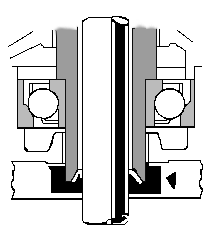In many user applications pump manufacturers desire to use a hollow shaft motor with an end face type mechanical seal. In order to eliminate possible shaft whip that may be injurious to this particular seal, a steady bushing is required.
In high thrust pump applications, vertical HOLLOSHAFT (only) motors are sometimes requested with steady bushings. These are motor mounted near the "P" base, are the same size as the coupling bore, and center the pump head shaft to within .002 inches TIR inside the motor shaft. When a motor is connected to the pump, the motor shaft, pump shaft and steady bushing all rotate together and have the mechanical stability of a vertical solid shaft motor.
As a general statement all 2-pole motors and pumps with mechanical seals in their discharge head require steady bushings. Another common use is when long bearing spans exist between the stuffing box bearing and the motor coupling due to tall fabricated discharge heads or high ring bases. Here, steady bushings are used to minimize potential shaft critical speed (resonance) problems.
Steady bushings are used with either bolted couplings or motors equipped with a non-reverse ratchet (NRR). They are not recommended for use on motors with a self-release coupling (SRC) as their tight tolerance may inhibit lateral pump shaft movement should the pump shaft unscrew.
Steady bushings are typically made of SAE 660 bearing bronze (or equivalent) and are available as kits* for all motors with grease lubricated lower bearings. These replace the v-groove rubber water slinger on the bottom end of the motor shaft. They are installed on the pump head shaft below the motor before securing it to the motor shaft with setscrews. Steady bushing kits for field installation are available for all Holloshaft motors except 5000 frame TEFC and 5800 and 6800 open motors. (*Production motors have kit attached to shipping skid.)
Steady bushings CANNOT BE FIELD INSTALLED ON SOME MOTORS WITH OIL BATH LOWER BEARINGS. On 5000 TEFC and 6800 ODP, the motor shaft does not extend beyond the lower bracket. The oil retaining tube which is pressed into the lower "P" base actually fits up into the quill of the HOLLOSHAFT bore. The steady bushing is pressed into the HOLLOSHAFT bore such that it bottoms out about 5 inches from the end of the shaft. The last machining operation on the motor shaft is to finish bore the steady bushing for concentricity and tolerance.
When reviewing specifications, look in the equipment section to determine if the pump OEM is required to provide a mechanical seal in the discharge head instead of packaging. If so required, include a steady bushing in your quote and point it out to your customer. This is especially important on motors that are not field-convertible. In order to retrofit these, the motor must be completely disassembled and much machining performed. It would also be prudent to quote steady bushings as an option on NEMA and TITAN® motors which are inverter driven. The OEM may need this feature to avoid pump shaft resonance problems and this will serve as a reminder to check his shaft critical speeds.
Steady Bushing Installation and Maintenance InstructionsSteady Bushing
Standard Design

Steady Bushing Acts as Stabilizer and Water
Slinger -- Concentric Within .002

